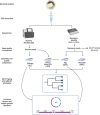Comparison of Illumina and Oxford Nanopore sequencing data quality for Clostridioides difficile genome analysis and their application for epidemiological surveillance
- PMID: 39885402
- PMCID: PMC11783910
- DOI: 10.1186/s12864-025-11267-9
Comparison of Illumina and Oxford Nanopore sequencing data quality for Clostridioides difficile genome analysis and their application for epidemiological surveillance
Abstract
Background: The burden of Clostridioides difficile as a nosocomial- and community-acquired pathogen has been increasing over the recent decades, including reports of severe outbreaks. Molecular and virulence genotyping are central for the epidemiological surveillance of this pathogen, but need to balance accuracy and rapid turnaround time of the results. While Illumina short-read sequencing has been adopted as the gold standard to investigate C. difficile virulence and transmission routes, little is known about the potential of Nanopore long-read sequencing in this field. The goal of our study was to compare sequencing and assembly quality of 37 C. difficile isolates using Illumina (SPAdes assembled) and Nanopore (Flye and Unicycler assembled) data alone, along with hybrid assemblies obtained with short-read polishing of long reads.
Results: Illumina sequencing produced reads with an average quality of 99.68% (Q25), while Nanopore sequencing produced reads reaching an average quality of 96.84% (Q15), showing a tenfold difference in quality. Sequence type (ST) designation from Nanopore assemblies failed to detect ST5, ST7, ST8, ST13 and ST49, while ST designation based on unpolished Nanopore reads using Krocus was successful for all STs. Nanopore sequences exhibited an average of 640 base errors per genome (~ 0.015% substitution rate), which was reflected by the incorrect assignment of over 180 alleles in core genome multilocus sequence typing (cgMLST) analysis. As a result, Nanopore-derived phylogenies were not as accurate as the Illumina reference, and therefore inadequate for precise investigation of transmission events. Both sequencing platforms provided comparable, satisfactory results for the detection of virulence genes tcdA, tcdB, cdtAB and in-frame deletions in tcdC.
Conclusion: Compared to Illumina, Nanopore has higher error rate, which limits its application for high-resolution epidemiological surveillance. However, the short analysis time, lower cost and more simple procedure combined with correctly identified STs and virulence genes, makes it an alternative when fast and less detailed analyses are preferred.
Keywords: Clostridioides difficile; Epidemiological surveillance; Genotyping; Illumina; Oxford Nanopore; Whole genome sequencing (WGS).
© 2025. The Author(s).
Conflict of interest statement
Declarations. Ethical approval: No ethical approval was required for this study since the data used was obtained as part of our routine surveillance program. Competing interests: The authors declare no competing interests.
Figures



References
-
- Bartlett JG, Gerding DN. Clinical recognition and diagnosis of Clostridium difficile infection. Clin Infect Dis. 2008;46(Suppl 1):S12–18. - PubMed
-
- Bouza E. Consequences of Clostridium difficile infection: understanding the healthcare burden. Clin Microbiol Infect. 2012;18:5–12. - PubMed
-
- Jones AM, Kuijper EJ, Wilcox MH. Clostridium difficile: a European perspective. J Infect. 2013;66:115–28. - PubMed
-
- Leffler DA, Lamont TJ. Editorial:not so nosocomial anymore: the growing threat of Community-AcquiredClostridium difficile. Official J Am Coll Gastroenterol| ACG. 2012;107:96. - PubMed
-
- Ofori E, Ramai D, Dhawan M, Mustafa F, Gasperino J, Reddy M. Community-acquired Clostridium difficile: epidemiology, ribotype, risk factors, hospital and intensive care unit outcomes, and current and emerging therapies. J Hosp Infect. 2018;99:436–42. - PubMed
Publication types
MeSH terms
LinkOut - more resources
Full Text Sources
Research Materials

